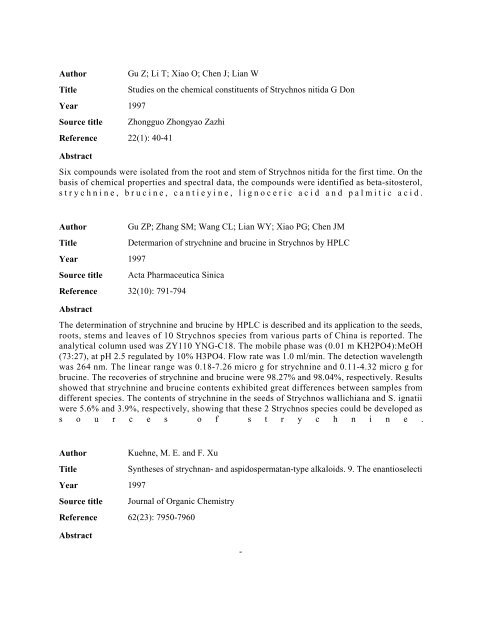Strychnos 1990 - 2004 - Crops for the Future
Strychnos 1990 - 2004 - Crops for the Future
Strychnos 1990 - 2004 - Crops for the Future
You also want an ePaper? Increase the reach of your titles
YUMPU automatically turns print PDFs into web optimized ePapers that Google loves.
Author<br />
Title<br />
Year<br />
Source title<br />
Reference<br />
Gu Z; Li T; Xiao O; Chen J; Lian W<br />
Studies on <strong>the</strong> chemical constituents of <strong>Strychnos</strong> nitida G Don<br />
1997<br />
Zhongguo Zhongyao Zazhi<br />
22(1): 40-41<br />
Abstract<br />
Six compounds were isolated from <strong>the</strong> root and stem of <strong>Strychnos</strong> nitida <strong>for</strong> <strong>the</strong> first time. On <strong>the</strong><br />
basis of chemical properties and spectral data, <strong>the</strong> compounds were identified as beta-sitosterol,<br />
strychnine, brucine, cantieyine, lignoceric acid and palmitic acid.<br />
Author<br />
Title<br />
Year<br />
Source title<br />
Reference<br />
Gu ZP; Zhang SM; Wang CL; Lian WY; Xiao PG; Chen JM<br />
Determarion of strychnine and brucine in <strong>Strychnos</strong> by HPLC<br />
1997<br />
Acta Pharmaceutica Sinica<br />
32(10): 791-794<br />
Abstract<br />
The determination of strychnine and brucine by HPLC is described and its application to <strong>the</strong> seeds,<br />
roots, stems and leaves of 10 <strong>Strychnos</strong> species from various parts of China is reported. The<br />
analytical column used was ZY110 YNG-C18. The mobile phase was (0.01 m KH2PO4):MeOH<br />
(73:27), at pH 2.5 regulated by 10% H3PO4. Flow rate was 1.0 ml/min. The detection wavelength<br />
was 264 nm. The linear range was 0.18-7.26 micro g <strong>for</strong> strychnine and 0.11-4.32 micro g <strong>for</strong><br />
brucine. The recoveries of strychnine and brucine were 98.27% and 98.04%, respectively. Results<br />
showed that strychnine and brucine contents exhibited great differences between samples from<br />
different species. The contents of strychnine in <strong>the</strong> seeds of <strong>Strychnos</strong> wallichiana and S. ignatii<br />
were 5.6% and 3.9%, respectively, showing that <strong>the</strong>se 2 <strong>Strychnos</strong> species could be developed as<br />
s o u r c e s o f s t r y c h n i n e .<br />
Author<br />
Title<br />
Year<br />
Source title<br />
Reference<br />
Abstract<br />
Kuehne, M. E. and F. Xu<br />
Syn<strong>the</strong>ses of strychnan- and aspidospermatan-type alkaloids. 9. The enantioselecti<br />
1997<br />
Journal of Organic Chemistry<br />
62(23): 7950-7960<br />
-
















